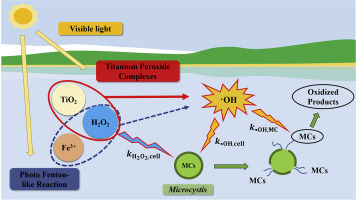当前位置:
X-MOL 学术
›
Water Res.
›
论文详情
Our official English website, www.x-mol.net, welcomes your
feedback! (Note: you will need to create a separate account there.)
Exposure of Microcystis aeruginosa to hydrogen peroxide and titanium dioxide under visible light conditions: Modeling the impact of hydrogen peroxide and hydroxyl radical on cell rupture and microcystin degradation
Water Research ( IF 11.4 ) Pub Date : 2018-05-14 , DOI: 10.1016/j.watres.2018.05.023 Che-Wei Chang , Xiangchen Huo , Tsair-Fuh Lin
 as well as
as well as  OH
OH  under visible light successfully separated the individual effects of H2O2 and
under visible light successfully separated the individual effects of H2O2 and  OH on Microcystis. The dual-oxidant models were further validated with additional experiments, making the models more convincing. Finally, the dual-oxidant cell rupture models were integrated with the MC degradation model and well predicted the observed MCs concentrations in the experimental systems. The results of this study not only demonstrate the potential application of H2O2 and TiO2 for the control of cyanobacteria and metabolites in natural water bodies, but also provide a new methodology to differentiate the individual contributions of the two oxidants, H2O2 and
OH on Microcystis. The dual-oxidant models were further validated with additional experiments, making the models more convincing. Finally, the dual-oxidant cell rupture models were integrated with the MC degradation model and well predicted the observed MCs concentrations in the experimental systems. The results of this study not only demonstrate the potential application of H2O2 and TiO2 for the control of cyanobacteria and metabolites in natural water bodies, but also provide a new methodology to differentiate the individual contributions of the two oxidants, H2O2 and  OH, on cell rupture, thus giving a novel way to more precisely determine the effective doses of applied oxidants for cyanobacteria control.
OH, on cell rupture, thus giving a novel way to more precisely determine the effective doses of applied oxidants for cyanobacteria control.
中文翻译:

铜绿微囊藻在可见光条件下的过氧化氢和二氧化钛暴露:模拟过氧化氢和羟基自由基对细胞破裂和微囊藻毒素降解的影响
 也
也  哦
哦  在可见光下成功分离出H 2 O 2和
在可见光下成功分离出H 2 O 2和 OH对微囊藻。通过其他实验进一步验证了双氧化剂模型,从而使模型更具说服力。最后,将双氧化剂细胞破裂模型与MC降解模型整合在一起,并很好地预测了实验系统中观察到的MC浓度。这项研究的结果不仅证明了H 2 O 2和TiO 2在控制天然水体中的蓝细菌和代谢物方面的潜在应用,而且还提供了一种新的方法来区分两种氧化剂H 2 O的各自贡献。2和
OH对微囊藻。通过其他实验进一步验证了双氧化剂模型,从而使模型更具说服力。最后,将双氧化剂细胞破裂模型与MC降解模型整合在一起,并很好地预测了实验系统中观察到的MC浓度。这项研究的结果不仅证明了H 2 O 2和TiO 2在控制天然水体中的蓝细菌和代谢物方面的潜在应用,而且还提供了一种新的方法来区分两种氧化剂H 2 O的各自贡献。2和 OH在细胞破裂后,因此提供了一种新颖的方法,可以更精确地确定用于控制蓝细菌的所施加氧化剂的有效剂量。
更新日期:2018-05-15
OH在细胞破裂后,因此提供了一种新颖的方法,可以更精确地确定用于控制蓝细菌的所施加氧化剂的有效剂量。
更新日期:2018-05-15
Water Research ( IF 11.4 ) Pub Date : 2018-05-14 , DOI: 10.1016/j.watres.2018.05.023 Che-Wei Chang , Xiangchen Huo , Tsair-Fuh Lin

|
The aims of this study are to evaluate, under visible light conditions, the ability of H2O2 and TiO2 to produce
OH, their quantitative impacts on the cell integrity of Microcystis, and the subsequent release and degradation of microcystins (MCs). A sequential reaction model was developed, including one sub-model to simulate the rupture kinetics for cell integrity of Microcystis, and another to describe the release and degradation of MCs. For cell rupture, the dual-oxidant Delayed Chick-Watson model (DCWM) and dual-oxidant Hom model (HM) were first proposed and developed, giving excellent simulation results of cell rupture kinetics. Kinetic rate constants between Microcystis cells and H2O2 OH
OH  OH on Microcystis. The dual-oxidant models were further validated with additional experiments, making the models more convincing. Finally, the dual-oxidant cell rupture models were integrated with the MC degradation model and well predicted the observed MCs concentrations in the experimental systems. The results of this study not only demonstrate the potential application of H2O2 and TiO2 for the control of cyanobacteria and metabolites in natural water bodies, but also provide a new methodology to differentiate the individual contributions of the two oxidants, H2O2 and
OH on Microcystis. The dual-oxidant models were further validated with additional experiments, making the models more convincing. Finally, the dual-oxidant cell rupture models were integrated with the MC degradation model and well predicted the observed MCs concentrations in the experimental systems. The results of this study not only demonstrate the potential application of H2O2 and TiO2 for the control of cyanobacteria and metabolites in natural water bodies, but also provide a new methodology to differentiate the individual contributions of the two oxidants, H2O2 and  OH, on cell rupture, thus giving a novel way to more precisely determine the effective doses of applied oxidants for cyanobacteria control.
OH, on cell rupture, thus giving a novel way to more precisely determine the effective doses of applied oxidants for cyanobacteria control.
中文翻译:

铜绿微囊藻在可见光条件下的过氧化氢和二氧化钛暴露:模拟过氧化氢和羟基自由基对细胞破裂和微囊藻毒素降解的影响
这项研究的目的是评估在可见光条件下H 2 O 2和TiO 2产生氢的能力。
OH,其对微囊藻细胞完整性的定量影响,以及随后的微囊藻毒素(MCs)释放和降解。建立了顺序反应模型,包括一个用于模拟微囊藻细胞完整性破裂动力学的子模型,另一个用于描述MCs释放和降解的子模型。对于细胞破裂,首先提出并开发了双氧化剂延迟Chick-Watson模型(DCWM)和双氧化剂Hom模型(HM),从而给出了优异的细胞破裂动力学模拟结果。微囊藻细胞与H 2 O 2之间的动力学速率常数 哦
哦  OH对微囊藻。通过其他实验进一步验证了双氧化剂模型,从而使模型更具说服力。最后,将双氧化剂细胞破裂模型与MC降解模型整合在一起,并很好地预测了实验系统中观察到的MC浓度。这项研究的结果不仅证明了H 2 O 2和TiO 2在控制天然水体中的蓝细菌和代谢物方面的潜在应用,而且还提供了一种新的方法来区分两种氧化剂H 2 O的各自贡献。2和
OH对微囊藻。通过其他实验进一步验证了双氧化剂模型,从而使模型更具说服力。最后,将双氧化剂细胞破裂模型与MC降解模型整合在一起,并很好地预测了实验系统中观察到的MC浓度。这项研究的结果不仅证明了H 2 O 2和TiO 2在控制天然水体中的蓝细菌和代谢物方面的潜在应用,而且还提供了一种新的方法来区分两种氧化剂H 2 O的各自贡献。2和 OH在细胞破裂后,因此提供了一种新颖的方法,可以更精确地确定用于控制蓝细菌的所施加氧化剂的有效剂量。
OH在细胞破裂后,因此提供了一种新颖的方法,可以更精确地确定用于控制蓝细菌的所施加氧化剂的有效剂量。











































 京公网安备 11010802027423号
京公网安备 11010802027423号